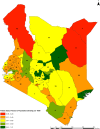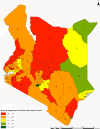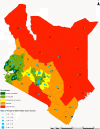The public sector nursing workforce in Kenya: a county-level analysis
- PMID: 24467776
- PMCID: PMC3913960
- DOI: 10.1186/1478-4491-12-6
The public sector nursing workforce in Kenya: a county-level analysis
Abstract
Background: Kenya's human resources for health shortage is well documented, yet in line with the new constitution, responsibility for health service delivery will be devolved to 47 new county administrations. This work describes the public sector nursing workforce likely to be inherited by the counties, and examines the relationships between nursing workforce density and key indicators.
Methods: National nursing deployment data linked to nursing supply data were used and analyzed using statistical and geographical analysis software. Data on nurses deployed in national referral hospitals and on nurses deployed in non-public sector facilities were excluded from main analyses. The densities and characteristics of the public sector nurses across the counties were obtained and examined against an index of county remoteness, and the nursing densities were correlated with five key indicators.
Results: Of the 16,371 nurses in the public non-tertiary sector, 76% are women and 53% are registered nurses, with 35% of the nurses aged 40 to 49 years. The nursing densities across counties range from 1.2 to 0.08 per 1,000 population. There are statistically significant associations of the nursing densities with a measure of health spending per capita (P value = 0.0028) and immunization rates (P value = 0.0018). A higher county remoteness index is associated with explaining lower female to male ratio of public sector nurses across counties (P value <0.0001).
Conclusions: An overall shortage of nurses (range of 1.2 to 0.08 per 1,000) in the public sector countrywide is complicated by mal-distribution and varying workforce characteristics (for example, age profile) across counties. All stakeholders should support improvements in human resources information systems and help address personnel shortages and mal-distribution if equitable, quality health-care delivery in the counties is to be achieved.
Figures










References
-
- Joint Learning Initiative. Human resources for health: overcoming the crisis. Cambridge, MA: Global Equity Initiative; 2004.
-
- World Health Organization. The world health report - working together for health. Geneva: World Health Organization; 2006.
-
- Aiken LH, Clarke SP, Sloane DM. Hospital staffing, organization, and quality of care: cross-national findings. Int J Qual Health Care. 2002;14:5–13. - PubMed
Publication types
MeSH terms
Grants and funding
LinkOut - more resources
Full Text Sources
Other Literature Sources
Research Materials

